
Academic studies can be fascinating... and totally confusing. So we decided to strip away all of the scientific jargon and break them down for you.
The Background
As far as researchers are concerned, women are the more sexually fluid gender. Previous studies have found that there are higher rates of bisexual and "mostly heterosexual" identities among women, and their sexual identities are often less binary than those of men. This is taken to mean -- rightly or wrongly -- that women on the whole are more likely to be attracted (at least to some degree) to both sexes, whether they identify as gay, straight, bisexual or pansexual. While this concept is fairly established, researchers have yet to pin down why women tend to exhibit more sexual fluidity throughout their lives.
A new study from the University of Notre Dame looks at how particular life factors might influence women to swing one way or the other -- or somewhere in between.
The Setup
Researchers used data from 5,018 women and 4,191 men who participated in the National Longitudinal Study of Adolescent to Adult Health from 1994 to 2008. At various phases of the study, participants reported their sexual identities on a scale of 100 percent heterosexual, mostly heterosexual, bisexual, mostly homosexual and 100 percent homosexual. They were also asked to report their same-sex attraction levels and their same-sex sexual experiences. Then, they provided a roster of past and present romantic and sexual partners.
In addition to information on their sexuality, each participant listed the highest level of education he or she had achieved during each interview that occurred in the 14-year span of the study. They also reported if they had any children and when those children were born so that the researchers could categorize their answers into the very general categories "early first births" (around age 22) and "normatively-timed births" (around age 28). Finally, the interviewers rated each participant's physical attractiveness on a scale of one to five. This was meant to serve as another measure of social context, but it's safe to assume that the subjective ratings weren't exactly scientific.
The Findings
As other studies have suggested, the researchers found that more women than men considered themselves bisexual, and women were more likely to change their sexual identity over the course of their lives. But this research added a bit more nuance to those concepts: Social factors, like educational attainment and physical attractiveness, were significantly associated with how women identified on the sexual spectrum. No such link was found for men.
Women in the study were more likely to identify as heterosexual if they reached higher levels of education, avoided "early first births" and were considered more physically attractive by the interviewers in the study. Higher educational attainment was also associated with less change over time in a woman's sexual identity.
The researchers argued that, if heterosexuality is the societal "default," the pressure to conform to that norm might be strongest when a sexually fluid woman is in an environment where she can easily find herself in "socially-approved heterosexual relationships." They state:
"Highly educated, physically attractive, childless women have greater access to desirable male partners ... For such women, heterosexuality may be the most obvious path and also the path of least resistance, even if they experience some degree of both other-sex and same-sex attraction."
The Takeaway
Of course, the researchers aren't suggesting that any of these life factors cause women to sexually identify in a specific way or that people consciously "choose" their sexuality. Rather, they merely suggest that social context may play a role in whether or not a woman who is more sexually fluid acts on that fluidity and claims a less heteronormative label.
Keep in mind, however, that the researchers never asked participants why they identified the way they did, so this theory is merely an educated guess.
It's also important to note that, even though this study didn't find a link between male sexual identity and social context, that doesn't necessarily mean that men aren't as sexually fluid as women. It might just be that society as a whole is less accepting of bisexual men, so they have to push through a specific kind of stigma to openly explore their sexuality.
But when it comes to women, this study and the ones that came before it are beginning to create a more complete picture of female sexuality. And that picture is becoming increasingly complex.
Also on HuffPost:

